His Dark Materials: Secrets of Cittàgazze and the Meaning of Pan’s Different Forms
Production designer Joel Collins and Framestore VFX supervisor Russell Dodgson take Den of Geek behind the scenes on the design secrets of His Dark Materials season two
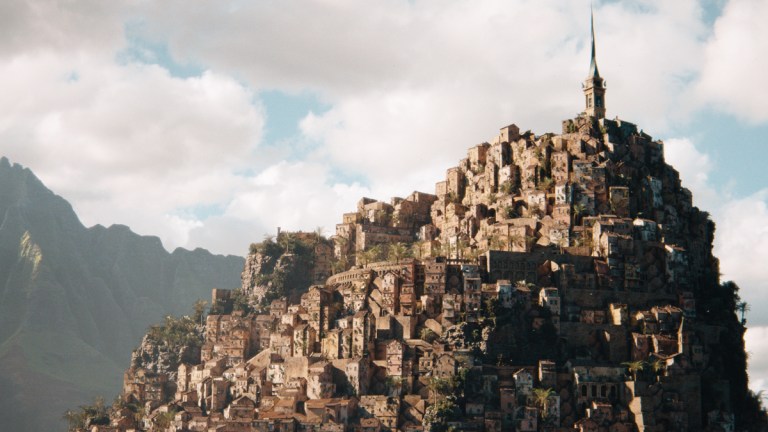
The terrible problem of creating sets for film and television, says His Dark Materials production designer Joel Collins, is that the very best work is invisible. “When you build a world that isn’t real but looks real, everyone thinks you didn’t do anything! You must have just stayed at home or popped along to Oxford and dialled it in.”
“Or you just went to Italy,” laughs Framestore VFX Supervisor Russell Dodgson, whose team are responsible for, among many other computer-generated elements, His Dark Materials’ daemons.
To make Cittàgazze, one of season two’s big new locations, the team didn’t just go to Italy. They went everywhere, borrowing styles and inspiration from around the world and bringing it home to a backlot in Cardiff, where the spiralling town was built from scratch.
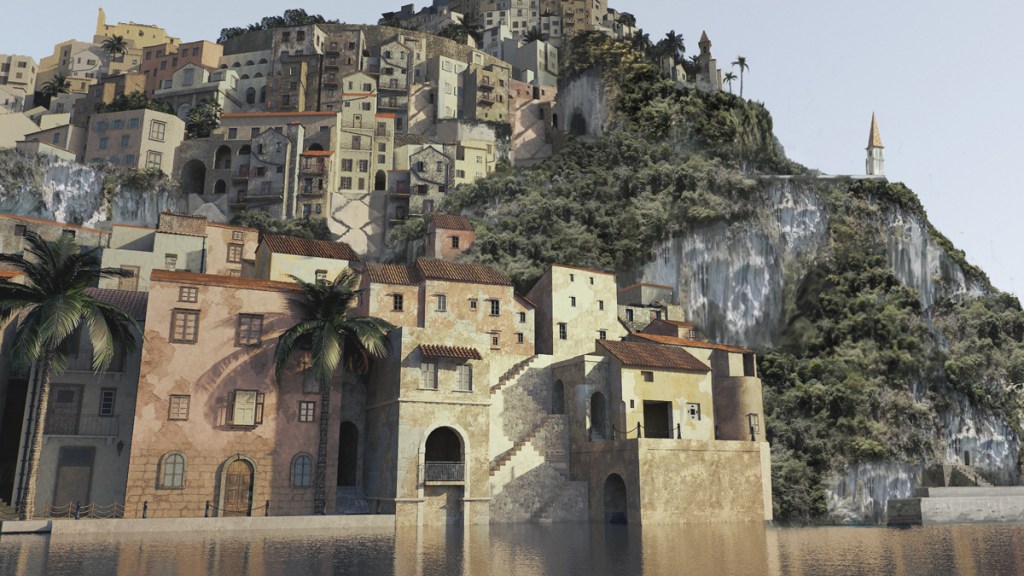
“In a lot of world-building fantasy shows, it’s about making the most ridiculous landscape and having big monsters chase everyone around,” says Dodgson. “But a big part of mine and Joel’s jobs are flavouring the story, giving it seasoning rather than smashing you in the face with it. If a daemon can just show a hint of subtext without overpowering the main performance, then we’ve done our job on the VFX side. With Joel’s stuff, it’s very rare that he hits you with a sledgehammer visually.”
It’s about including detail in such a way that viewers don’t stare directly at it, but would sense if it wasn’t there, says Collins. “Without it, things would look cardboardy or fake.”
Now that Cittàgazze has been unveiled on screen, Collins and Dodgson give Den of Geek a closer look at episode one’s behind-the-scenes details and Easter Eggs, from the town to bamfing witches, and the meaning behind Pan’s new look…
Cittàgazze: the City of Magpies
Behind the Bad Wolf studios in Cardiff, on a patch of land where the cast trailers were stood in season one, Joel Collins and his design team built the streets of Cittàgazze. There was no question of filming the six month shoot on location – no tourist town would allow such a takeover. 120 real locations though, provided inspiration to the design team.
“We went to Morocco and bought huge amounts of windows and doors – the ones we didn’t make,” says Collins. “We went all over Europe buying details. It’s an Italianate town, an intriguing Mediterranean, slightly exotic place.” The town represents a new start for Lyra after the hardships of the North. “We needed to start afresh. Everything she was doing was moving on, so tonally the town needed to feel like a place of intrigue and interest to take her away from everything that’s gone before.”
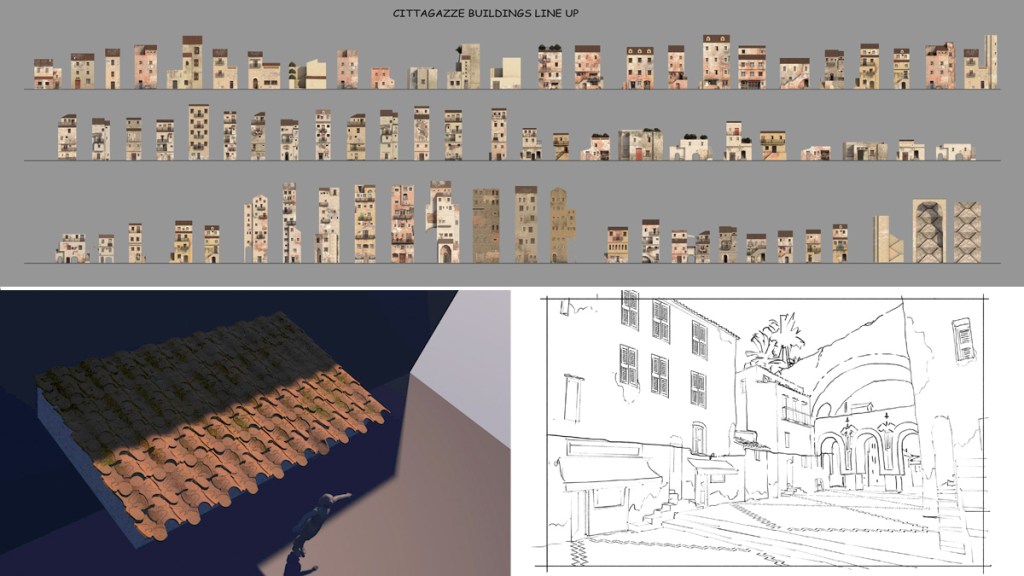
The concept for Cittàgazze’s mountainous land and seascapes were inspired by Guilin in China and Hawaii’s Kauai. The VFX team spent six days in Kauai, filming helicopter and ground shots to get coverage not available in Wales. The end result, says Dodgson, was a slightly weird mix of tropical and Mediterranean, which was perfect for the town’s multiple nature as a crossroads between worlds. It’s a magpie city, stealing elements from here, there and everywhere.
“If you walk around that set, every banister has got the knife sculpted into it,” enthuses Dodgson. “The bricks are magpie-shaped. It’s filled with detail and everything is thought about. You can’t just do shots of those things, because there’s no point of view for that, it’s too on-the-nose, as if you’re just watching your own work too much, but when it’s there just seasoning the tone of it, it’s at its best.”
M.C. Escher: a Lost Cittàgazzan?
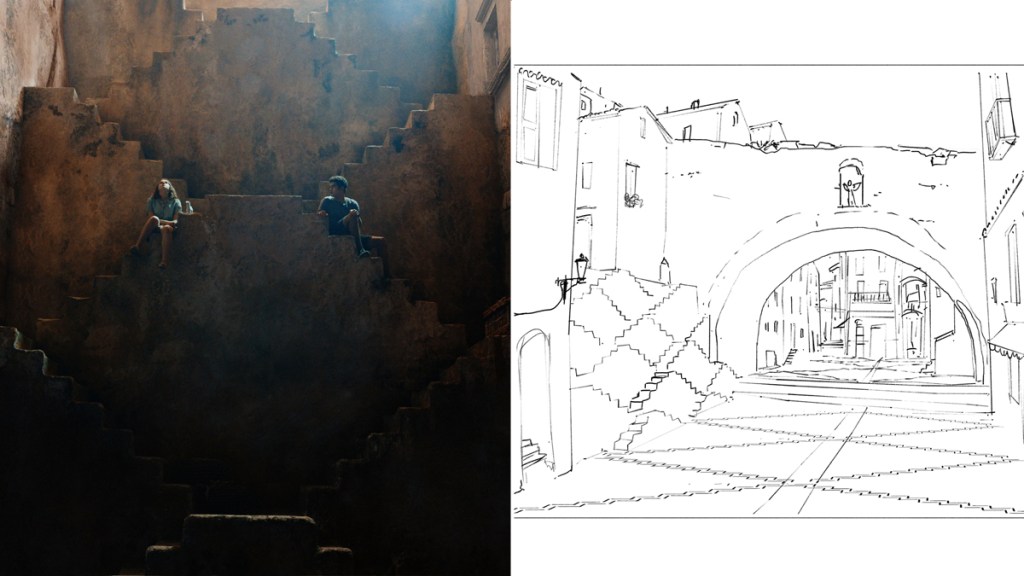
When production designer Joel Collins was creating Cittàgazze’s spiralling town, he took inspiration from an old favorite. “I’ve always liked M.C. Escher for the heaven and hell connection in his work, the way he weaves things invisibly, merging from one to the next.” Cittàgazze’s staircase motif and cleverly interlocking tile designs are tributes to the work of Escher, who was famed for his optical illusions.
While researching Escher’s work, Collins developed a fan theory about the Dutch artist and mathematician. “I found that he’d done a huge amount of drawings of Italian mountain towns. and I felt that I’d stumbled across an actual Cittàgazzan, who’d fallen into our world through a window and never made it back!
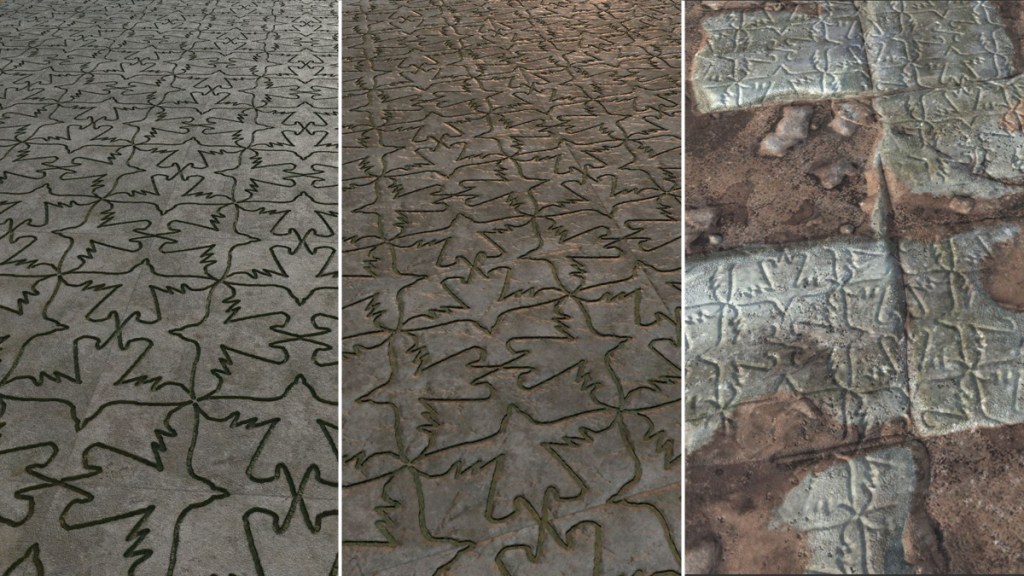
“If you look at his work, it’s almost as if he’s drawing Cittàgazze in lots of ways. I built this weird story in my head that ultimately, Escher had spent his life stuck in our world, drawing his way out of it, trying to explain to everyone where he was from, and everyone just thought he was bonkers, but there he is constantly drawing these mountain towns and these weird connections going ‘I’m actually not from here!’”
Torre degli Angeli: the Tower of Angels
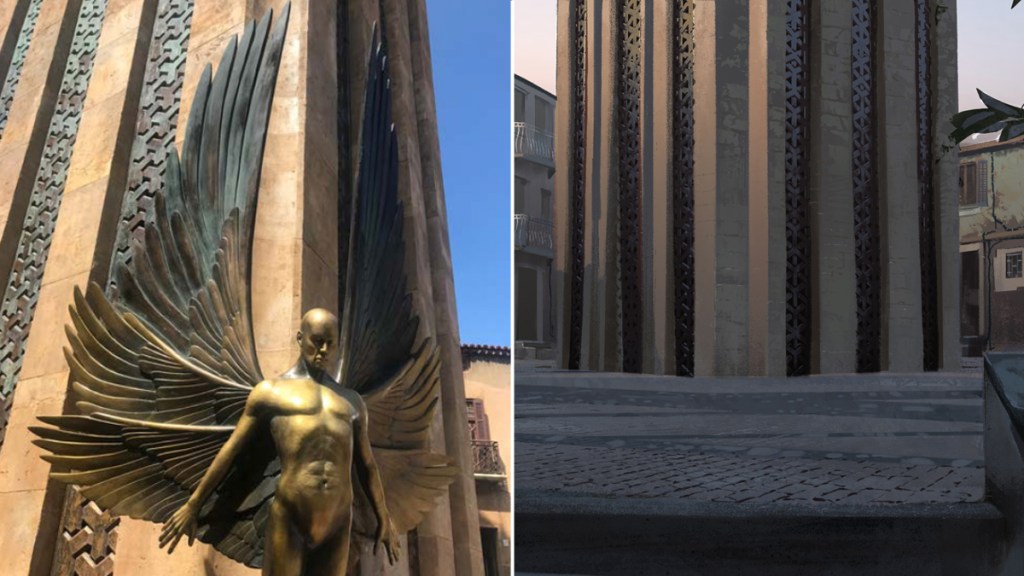
Look closely at the tower rising up over the spiralling town in this article’s header image and you’ll seen an important design echo. The tower’s spiked roof is twisted to match the base of the Subtle Knife (as glimpsed in the season two trailer here). The original idea, says Collins, was to have the tower topped by the knife. “I stuck the actual knife on top of the tower and it looked like a kid’s toy, it was absurd, it really didn’t work, so that’s how it became the twisted roof.”
It wasn’t easy to get right, notes Dodgson. “The reference to the knife in the design of the tower was the only thing that almost caught us out, but we managed to tweak our way through it. When you view a twist from below, it becomes a weird perspective-bender so me and Joel ended up adjusting it and playing around with a few design things.”
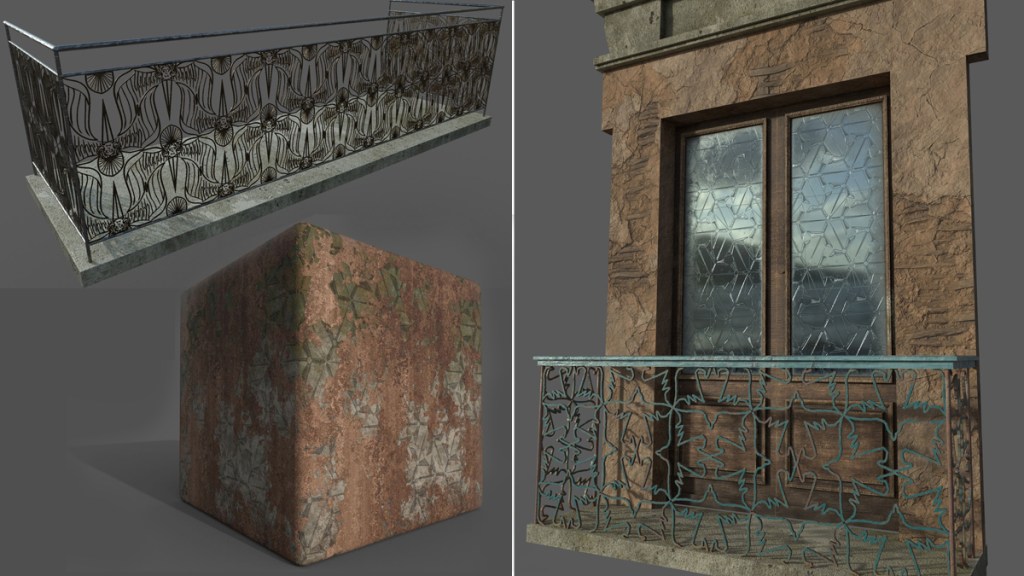
Each design element in His Dark Materials has a story explanation, even if it’s only for the designers to know. The team devised a centuries-old history for Cittàgazze’s island, which began life as a small mound of rock, says Collins. “We built a story around the fact that the knife was forged on that site 300 years earlier and that forge became the base of the tower. The tower was built up, up, up, all the way up to the skies for the angels to protect the knife at the top and the town grew around the tower. That means the tower fell through the floor deep into the underground and went all the way down to its original forge where the knife was made.”
Reinventing the Witches
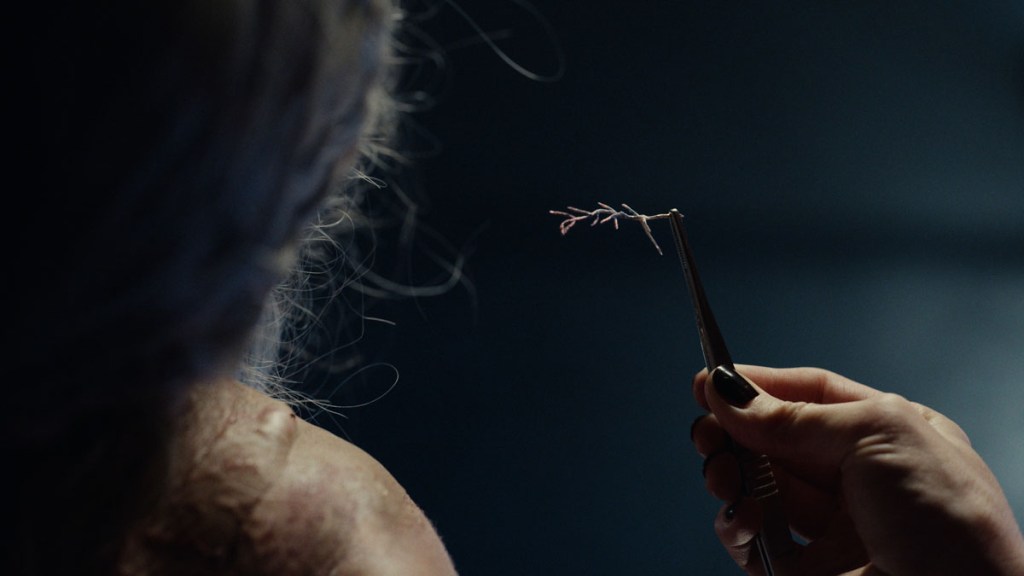
One change between His Dark Materials and Philip Pullman’s books fans will have noted in series one is that the TV series witches don’t fly using cloud-pine brooms. “They don’t get onto a broom and fly into the air like a witch does in a standard witchy way,” says Collins, who also serves as executive producer on the series. “We’ve reinvented witches to be what we think witches should be – as if this is what they’ve always been and everyone else got it wrong.”
As explained by a gruesome plot point in the series two opening episode, a witch’s cloud-pine is under their skin. “It’s in their system,” says Collins. “We’ve put the broom inside in the sense that the thing that allows them to fly is within them, within their DNA.”
Bamfing attacks
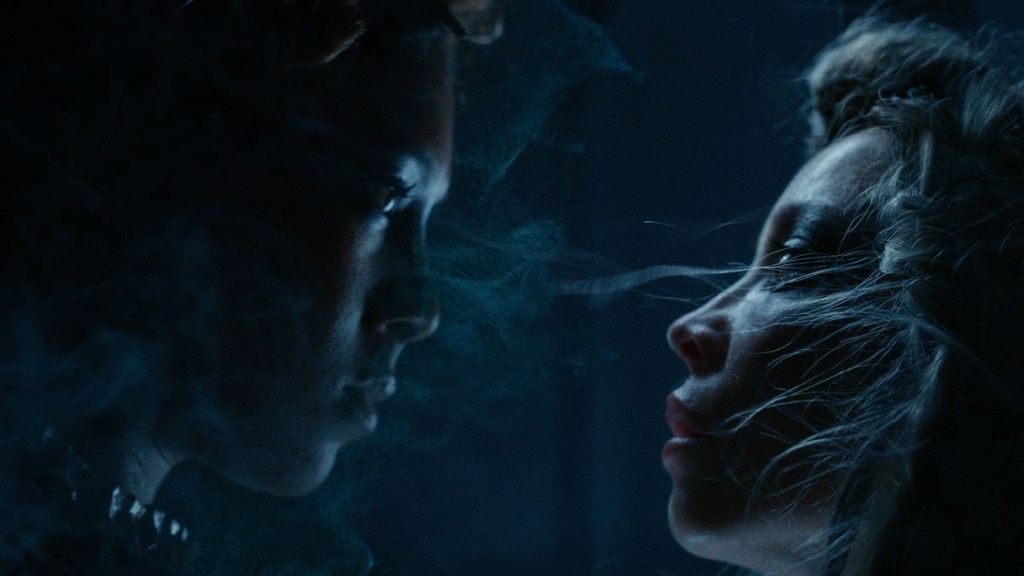
For the Witches’ fighting style, as demonstrated by Ruta Skadi in her attack on the Magisterium’s submarine, Framestore took inspiration from comic books. “We developed a sort of a riff on the old superhero idea of bamfing, which is disappearing from one place and turning up somewhere else,” explains Dodgson. “We turned it into a rush rather than an apparition. What’s great is that it gives them velocity but also punctuation. You can build a dynamic bam-bam-bam-bam! rhythm very quickly by punctuating them with bamfs.”
“There’s a mystery and a magic and a sensitivity but also an amazing deadliness to the witches, which Russell’s captured really well with the bamfing,” says Collins. “That action scene in the submarine was a complicated one to shoot to give them their sensitivity and viciousness at the same time. They’re quite sedate, lovely, emotional characters who are spiritual but also quite deadly.”
“We would match-animate the stunt double with our Ruta-double, then punctuate in-between so the bit you saw was always the most violent portion,” explains Dodgson. “Then we removed the bit in between so it’s just staccato violence. You can do it in a way that it feels violent, but it isn’t actually too violent for the 8pm time slot.”
Pan’s New Look
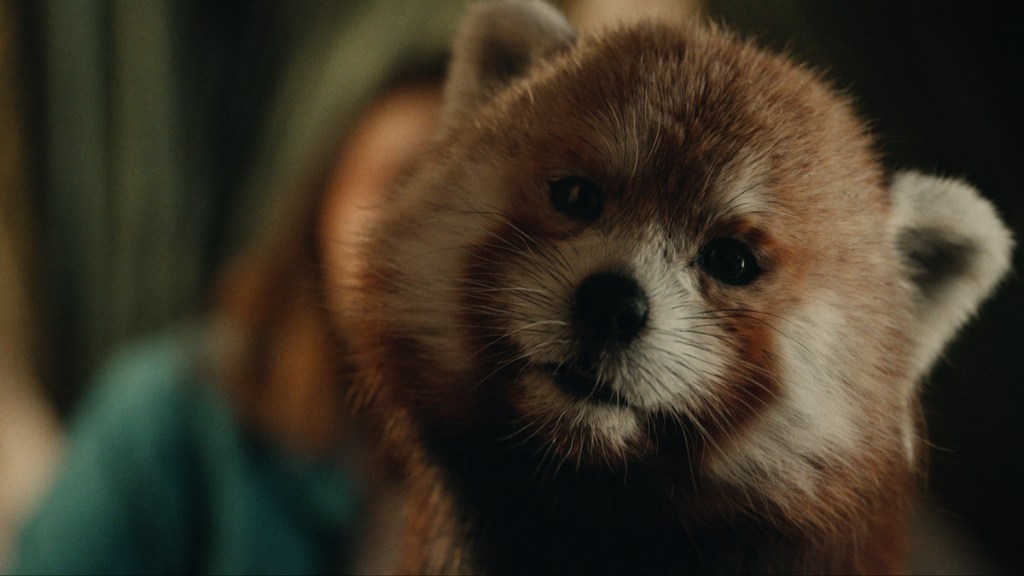
In Lyra’s world, the form an adult’s daemon takes reflects their nature: soldiers and servants tend to have dogs, while the villainous Magisterium teems with spiders, snakes, lizards and creepy-crawlies. Children’s daemons shift forms as they try on new identities. Those shifts aren’t random, explains Dodgson, but carefully chosen to reflect what’s happening in the story and a character’s emotions at a particular time. Pan’s white ermine form is Lyra’s default comfort daemon, appearing whenever she’s in need of reassurance. His pine marten form comes out on special occasions, when something of real significance is happening in the plot.
“In season one when Lyra goes North – which she’s always dreamed of – Pan becomes an Arctic creature because she’s been inspired by something new,” explains Dodgson. Lyra’s arrival in Cittàgazze sparks a different inspiration that gives Pan a brand new form – the red panda.
The red panda works well with Pan’s traditional forms because they’re sweet, says Dodgson, and they’re part-bear and part-mustelid, just like pine martens. The red panda’s slight adolescent clumsiness works really well to capture the sense of a teenage girl who’s just met an intriguing boy, and they’re exotic, reflecting Lyra’s strange new surroundings.
“There was a really great idea that in the end, fell by the wayside because of editorial pacing,” says Dodgson. “In Cittàgazze there’s a Red Panda brand of soda, and in one of the streets there’s a big mural advertising it. We did originally have a shot of Lyra looking up at the mural, and then later Pan turning into the red panda she’d seen. She’s something new, something more exotic, she’s excited about being around this new boy but she’s not so different that she’s left behind who she is.”
Learn more about Framestore’s His Dark Materials work here.
